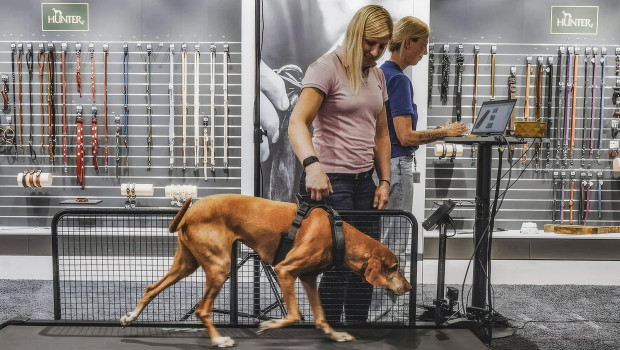Dog harnesses may be popular because they allow even young, boisterous or fearful dogs to be led safely without exposing their sensitive necks to rough handling. But what long-term impact do straps and buckles have on gait, i.e. on the health of the animals? Hunter has now investigated this again – what is the reason for this effort? Dr Julia Vietmeier, veterinarian and Hunter expert, explains: ‘Of course, you have a subjective perception of whether a harness fits or not. But that wasn't enough for us. We wanted to objectively analyse the comfort and effects of Hunter harnesses on gait.’
Sheila, Floki, Iken and 13 other four-legged friends from the Hunter pack were happy to take part in treadmill analyses in Bielefeld, reports Hunter. A thermal imaging camera and the special CanidGait treadmill with pressure measurement plate and cameras made the analysis possible. Sixteen dogs – from wire-haired dachshunds to German shepherds – walked and trotted across the treadmill, sometimes with and sometimes without harnesses.
Among others, the ‘Easy step in’ Hilo harness, the all-rounder Divo, the popular Maldon Y-harness and the Norwegian Racing harness were put to the test. Does the harness change the gait? According to the company, the pressure measurement plate, which records every paw print, every stride length and much more, gave the green light for the Hunter range. ‘We were able to show that our harnesses do not cause any harmful restrictions in the dogs' freedom of movement.’
A prerequisite for this result is a good fit. ‘The harness must not constrict because it is too tight nor chafe because it is too large.’ The second condition is that the buckles, seams and straps of the harness must be designed and manufactured in such a way that they do not chafe or pinch.
Consequences for animal health
Unsuitable, defective or inappropriate harnesses could have significant consequences for animal health: poorly fitting harnesses lead to protective postures, for example in the armpit area, and thus influence gait, according to Hunter. Studies have shown that this can restrict shoulder movement by up to ten degrees and shorten the overall stride length. Such incorrect and protective postures are detrimental to the dog's musculoskeletal system.
Impressions of the treadmill analysis can be seen in this video.

 Menü
Menü










 Print - digital - online
Print - digital - online








